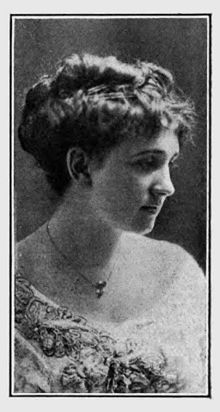Josephine Lovett
| Josephine Lovett | |
|---|---|
 |
|
| Born |
21 October 1877 San Francisco, California, USA |
| Died | 17 September 1958 (aged 80) Rancho Santa Fe, California, USA |
| Occupation | Scenario writer, adapter, screenwriter, and actress |
| Years active | 1916–1935 |
Josephine Lovett (21 October 1877 – 17 September 1958) was an American scenario writer, adapter, screenwriter and actress, active in films from 1916 to 1935. She was married to Canadian-born director, John Stewart Robertson. She is best known for her then-risqué film Our Dancing Daughters in 1928. Her screenplays typically included a heroine who was oftentimes economically and sexually independent.
Josephine, also known as Mrs. John Stewart Robertson, was born October 21, 1877 in San Francisco, California. Although she later returned to California, she temporarily moved to New York, New York, where she started her career as a successful stage actress at Haverly’s 14th Street Theatre, on Sixth Avenue. Her husband also worked as a stage actor briefly at Haverly’s 14th Street in 1903. Lovett worked as a stage actress from 1899-1906 and made a motion picture appearance as an actress in 1916. She played the character of “Rachel Blake” in the 1916 drama entitled The Ninety and Nine, directed by Ralph Ince at the Vitagraph Company. Lovett and her husband worked on numerous films together at Vitagraph, which was later bought by Warner Brothers in 1925. The Vitagraph films were not the only films they collaborated on. Eighteen of Lovett’s thirty-three film-acknowledgements (screenplay, adaption, scenario and actress) between 1916-1935 were directed by her husband, John. She was a major contributor to John’s success as she oftentimes assisted with his films’ scene visualization.
Prior to her involvement in the film industry, Lovett was a Broadway actress appearing in various plays from 1899 to 1915. One popular play was 1901's Tom Moore starring Andrew Mack. Josephine was one of the most prominent female writers of her time. She was known for her ability to capture female audiences while simultaneously appeasing censors. By doing so, she along with the other female screenwriters of her generation, helped elaborate the modernization of American mentality from Victorianism to the flapper. Her screenplays and scenarios consisted of sexually suggestive material, just skirting censors. She is best known for her 1930 Academy Award-nominated film Our Dancing Daughters, produced by the Metro-Goldwyn-Mayer Company and novelized by Winifred Van Duzer. The 1928 drama was famous actress Joan Crawford’s breakthrough role, where she played Diana Medford, also known as “Dangerous Diana”, a young rebellious woman representing Lovett’s typical risqué content and visuals. The film’s plot surrounds the flamboyant and wild lifestyle of best friends Diana and Ann, who are in love with the same man. Critics and reviews mentioned the viewing of exposed “undies and much stocking”, and complained that “cocktails, flasks and mad dancing appear in quite a number of episodes [and] it is quite unnecessary to depict an intoxicated girl, as is done for a considerable length of this film”. Despite these notions, the film earned Lovett a nomination in writing achievement at the Academy Awards in 1930. The film's success can also be attributed to the producers’ attempts at adding sound effects and a music track, an extraordinary feature prior to the “Talkies” in the 1930s.
...
Wikipedia
